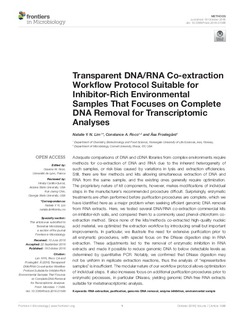| dc.description.abstract | Adequate comparisons of DNA and cDNA libraries from complex environments require 21 methods for co-extraction of DNA and RNA due to the inherent heterogeneity of such samples, 22 or risk bias caused by variations in lysis and extraction efficiencies. Still, there are few methods 23 and kits allowing simultaneous extraction of DNA and RNA from the same sample, and the 24 existing ones generally require optimization. The proprietary nature of kit components, 25 however, makes modifications of individual steps in the manufacturer’s recommended 26 procedure difficult. Surprisingly, enzymatic treatments are often performed before purification 27 procedures are complete, which we have identified here as a major problem when seeking 28 efficient genomic DNA removal from RNA extracts. Here, we tested several DNA/RNA co29 extraction commercial kits on inhibitor-rich soils, and compared them to a commonly used 30 phenol-chloroform co-extraction method. Since none of the kits/methods co-extracted high31 quality nucleic acid material, we optimized the extraction workflow by introducing small but 32 important improvements. In particular, we illustrate the need for extensive purification prior to 33 all enzymatic procedures, with special focus on the DNase digestion step in RNA extraction. 34 These adjustments led to the removal of enzymatic inhibition in RNA extracts and made it 35 possible to reduce genomic DNA to below detectable levels as determined by quantitative PCR. 36 Notably, we confirmed that DNase digestion may not be uniform in replicate extraction 37 reactions, thus the analysis of “representative samples” is insufficient. The modular nature of 38 our workflow protocol allows optimization of individual steps. It also increases focus on 39 additional purification procedures prior to enzymatic processes, in particular DNases, yielding 40 genomic DNA-free RNA extracts suitable for metatranscriptomic analysis. | nb_NO |

